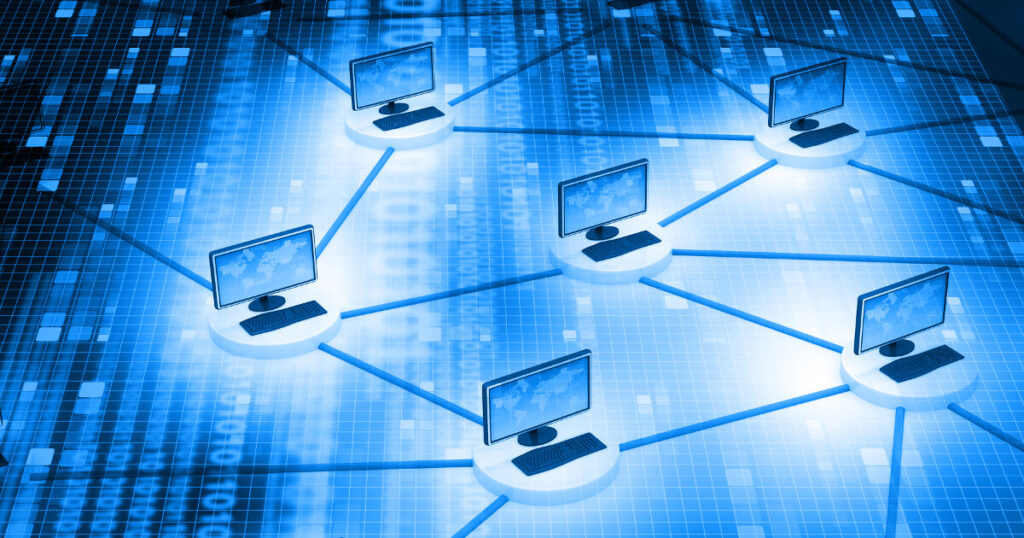During a broadcast, a device sends a message to all the other receiving points in a network. All devices that can receive this broadcast are part of a broadcast domain. How to limit this area?
What is a broadcast domain?¶
The term “broadcast domain” (or broadcast domain in English) refers to a network of devices that can receive a broadcast. The sending device sends the message to the broadcast address and all participants in the domain receive this transmission. To do this, the sending instance must not know the IP addresses of other devices.
A broadcast domain can cover an entire network, but this is not necessarily the case. Indeed, even within a local area network, several broadcast domains can be constituted. All connections within the domain share the same segment of layer 2. They are therefore interconnected at the data link layer.
In practice, almost all communication nodes interconnected by switches and repeaters belong to the same broadcast domain. The domain, on the other hand, stops at a router, because the network device operates at the network layer (layer 3). For this reason, computers that come into contact with each other over the Internet are not part of the same broadcast domain.
To subdivide a broadcast domain, potentially within the same Layer 2 segment, VLANs are used. These behave as if they were created from different physical networks. THE virtual networks thus limit a broadcast domain without the need to use more routers.

Why use a broadcast domain?¶
Within a network, it is important that devices can communicate with each other without creating direct connections. This applies in particular when the IP addresses of the other communication nodes are not known. This is why broadcasts take place regularly via ARP or DHCP, for example. when network information must first be requested.
However, these requests must be limited to a defined area, otherwise they would take too much time (for example when connecting via the Internet). They would also drown the rest of the network in a flood of useless communications. The broadcast domain therefore sets a clear framework stipulating which devices should be called via a broadcast.
Disadvantages of broadcast domains¶
In the majority of cases, broadcasts are decisive for ensuring smooth communication within a network. This is why we should not prevent domains. Problems then arise when a broadcast domain too large is selected. A broadcast is a message (that is, a small packet of data) sent to all participants in the domain. It clogs the network, as well as the devices that are part of it. In short, each request must be handled in some way, even if the information is ultimately of little relevance to the body concerned.
On home networks, this usually presents no problem, as the number of devices is small. However, on very large networks (trusts, public bodies, universities, etc.), it is important to subdivide these requests into separate domains. This reduces the unnecessary traffic which deteriorates the transmission speed. During subdivision, however, access to other domains is also blocked for services such as DHCP. This problem can be solved with technologies such as DHCP relay, allowing a broadcast domain to communicate across its boundaries.
Diffusion domain and collision domain: what’s the difference?¶
These two types of domains designate the logical subdivisions of a network. But they involve different challenges. The broadcast domain indicates which participants can be called by a broadcast. The collision domain is the part of a network where data packets can collide. This happens when two network devices simultaneously send data within a section (the so-called collision domain).
While a broadcast domain is only interrupted by a router, collision domains are already bounded by network switches. No collision can therefore occur between two terminals connected together by a switch, but a collision can occur between a switch and a terminal. Indeed, the two phenomena (diffusion and collision) act at different layers of the OSI model : a broadcast is sent to the data link layer (layer 2) while collisions go through the physical layer (layer 1).
| Broadcast domain | Collision domain |
|---|---|
| Logical division of a network | Logical division of a network |
| Applies to all devices that receive a broadcast. | Applies to all connections in collision. |
| Is limited by a router. | Is limited by switches. |
| Acts on layer 2. | Acts on layer 1. |
If you are new to networking technologies, be sure to check out the Digital Guide. You will discover other interesting topics that will allow you to better understand certain basic principles:




